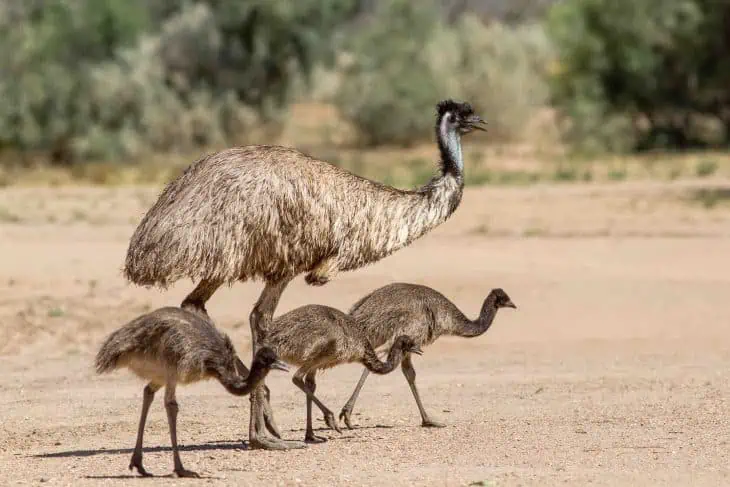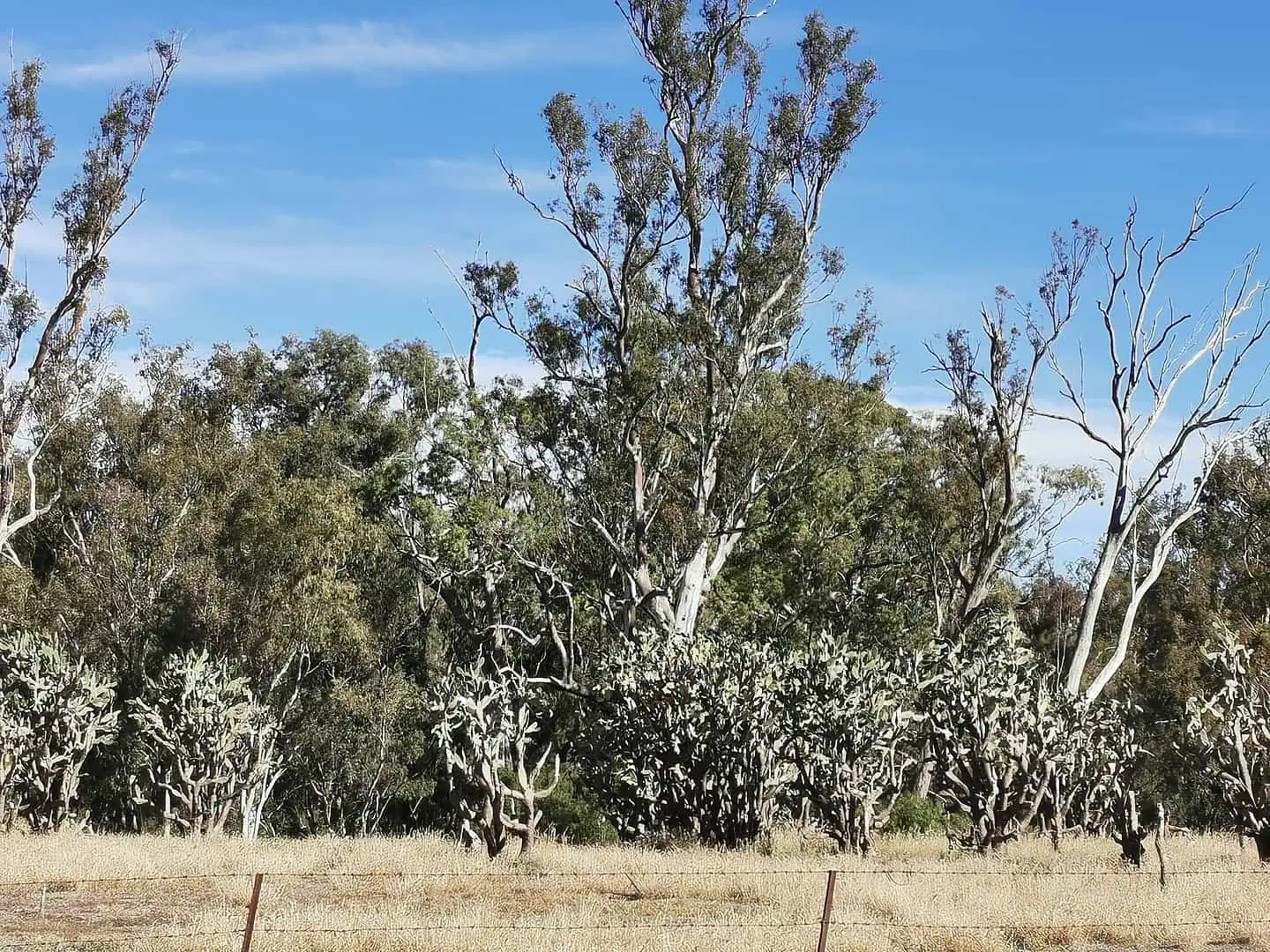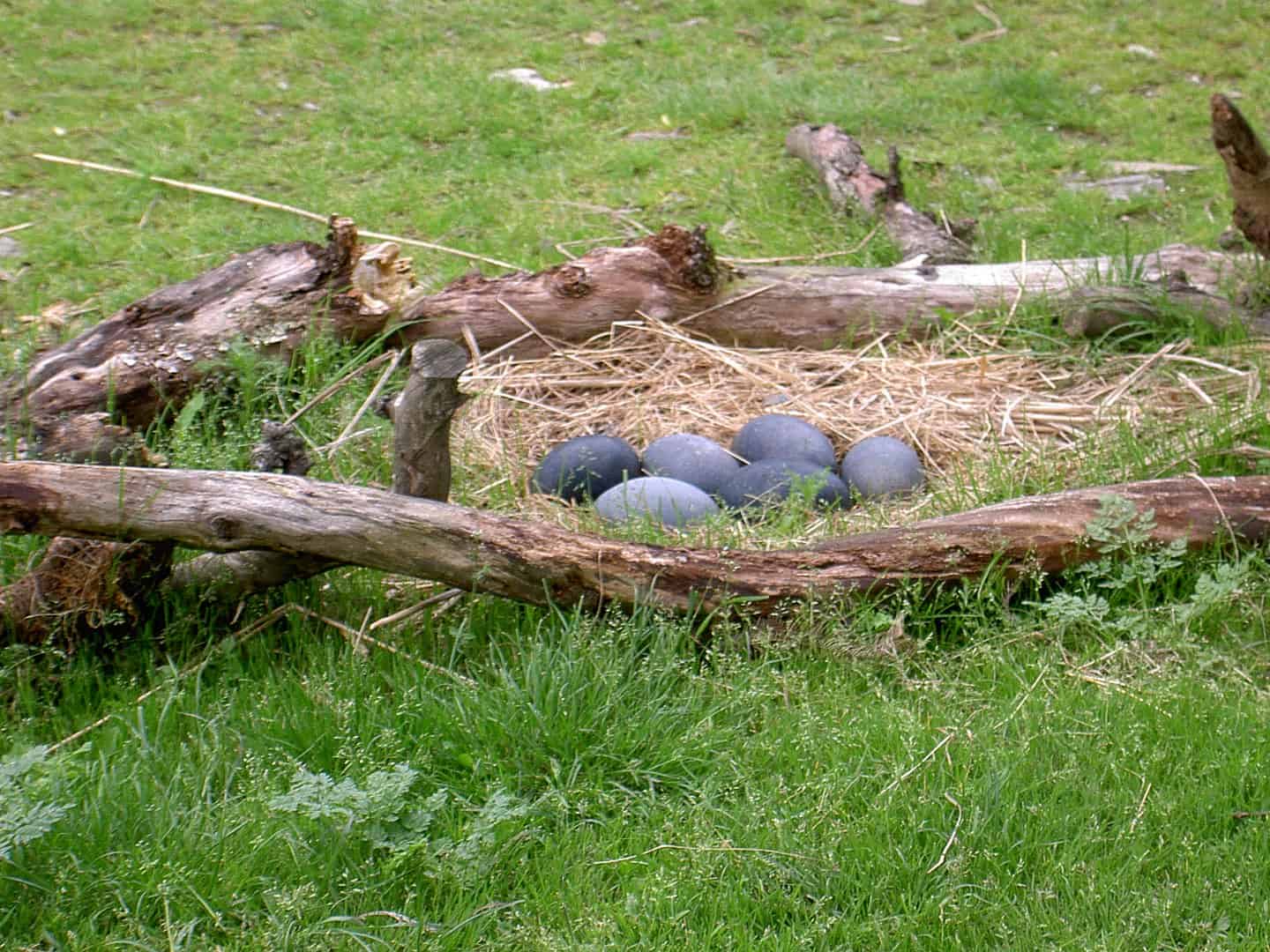
There are about 18,000 species of birds. Of those, emus – the long-limbed, long-necked Australian natives – are the world’s second-largest species in terms of height. Feathery, fast and friendly, many people want to have one as a pet. Unfortunately, only Australia is home to emus. One of the saddest emu facts for non-Australians, for sure!
Emus reside in most of the continent’s less populous parts, and while they can thrive in most environments, they stay away from deep woodland and harsh desert. Did you know that in Australia, they are just as popular as kangaroos? Emus rival the kangaroo as the most iconic animal of Australia. And while children think of koalas first when they hear of Australia, koalas just don’t have the same historical significance as the emu.
When European explorers explored the western coast of Australia in 1696, they saw emus for the first time. This happened during a search for the survivors of a ship that had gone missing two years before. The missing ship was led by Dutch captain Willem de Vlamingh. Did you know that before the arrival of the first Europeans in 1788, the birds were already a familiar sight on the eastern coast? The birds were originally recorded in the first Governor of New South Wales Arthur Phillip’s book “Voyage to Botany Bay.” This was published in 1789, under the name “New Holland Cassowary.
Learn more about these birds, add to your knowledge of emus, check out our 40 emu facts.
- With a maximum height of 1.9 meters, emus make up the world’s second-tallest birds after the ostrich.
- Emus also have the ability to run up to speeds of 50 kilometers per hour.
- On average, though, they usually run at speeds of around 48 kilometers per hour.
- When walking, an emu can cross a full meter in a single step.
- With a maximum weight of 60 kilograms, they also make up the world’s fifth heaviest bird.
- Europeans first encountered emus in 1696, while exploring Australia’s west coast.
- Dutch Captain Willem de Vlamingh led the expedition that first encountered emus.
- British Admiral Arthur Phillip first named the emus as New Holland cassowaries in his 1789 work, “Voyage to Botany Bay.
- British Ornithologist John Latham made the first scientific studies of emus in 1790.
- French ornithologist Louis Viellot gave them the scientific name of Dromiceius, which later changed into the modern Dromaius.
- Scientists today continue to argue on which name to use in official documents.
- In 1912, Australian ornithologist Gregory Matthews divided emus into 3 sub-species.
- Some scientists disagree with this division, instead arguing for only 2 sub-species.
- The emus living on Maria Island off Tasmania died out in the mid-1990s.
- Scientists in 2014 proposed reclassifying the species based on new genetic discoveries.
- Emu populations vary based on Australia’s annual rainfall.
- Scientists estimate that emus number at most around 725,000 birds.
- The stable emu population has earned them the conservation status of least concern.
- Dwarf emus once lived on Kangaroo and King Islands, only to die out in the 18th century.
- Other dwarf emus on Tasmania also died out in the mid-19th century.
The origins of the emu’s name remain uncertain today.
The most common theory states that the name “emu” was derived from an unknown Arabic word that Portuguese explorers first used for cassowaries in New Guinea. Given the similarities between the 2 birds, “emu,” was also used for Australian birds.
Based on another theory, emu came from ema, a Portuguese word generally used for big birds, such as ostriches and cranes. For their part, the Australian aborigines have their own names for the bird, with no connection to the name emu. For example, the Dja Dja Wurrung people call the birds barrimal, the Gunai people call them myoure, and the Jaadwa people call them courn.
Emus have unique adaptations of their own.
Emus can’t fly, but that doesn’t stop them from flapping their wings when they run. Scientists think this helps them keep their balance when running at a high speed, the same reason for the unique build of the emu’s pelvis. Similarly, an emu only has 3 toes, while most birds have 4. Emus also have thick pads under their feet, again to help them travel long distances on foot. They’ve got soft beaks as well, they use their beaks for grazing.
Emu feathers have distinct features.
Did you know that the tips of their feathers actually have the ability to absorb solar radiation? Together with their insulation ability, this helps keep the birds from overheating in the hot and dry Australian environment.
The build of their feathers also comes off as distinct, with a fur-like texture near the body, becoming grasslike towards the tips. Their color also varies based on their environment, giving the emu a form of natural camouflage. For example, emus in hotter and dryer areas tend to have reddish feathers. In contrast, emus in cooler and damper areas have generally darker colors for their feathers.
Emus live all over the Australian continent.
They usually live in the grassland and woodland regions, along the coast and nearby areas. They also used to avoid the desert interior, but human development has actually allowed emus to penetrate those areas over time. In particular, the adoption of modern irrigation led emus to enter areas they once avoided for lack of water. That said, emus tend to avoid humans and avoid places with lots of people. They do migrate annually, though, coming and going with the seasons to keep up with their food supply. This causes the bird to spend summer in Northern Australia, and winter in Southern Australia.
Emus sleep at night.
They settle down at sunset, but don’t actually stay asleep during the night. Instead, the birds wake up periodically to snack on their surroundings, or to relieve themselves before going back to sleep. Scientists observing the birds’ nighttime behavior note they usually wake up every 90 minutes, and stay awake for 20 minutes. They also note that when sleeping, emus fold their necks onto themselves, while crouching down against the ground.
The birds also arrange their feathers so that when it rains, they redirect the water to flow down to the ground. Scientists see this as another form of natural camouflage, making the emu look like a mound of earth to any predator in the dark.
Emus eat a wide variety of food.
Grass and acacia leaves make up the birds’ staple diet, and they also eat a variety of insects. Those include ants, beetles, cockroaches, crickets, grasshoppers, ladybugs, millipedes, and even spiders. In fact, scientists have since discovered that emus depend on eating insects for protein in their diet. They also have a symbiotic relationship with certain plants, whose seeds stay undigested when the emus eat them.
When the emu shits, they leave and scatter the seeds behind them, allowing them to grow in fertile soil. This actually caused an issue in Queensland, Australia in the early 20th century, when emus brought prickly pear seeds with them to the region. This forced the Australians to introduce measures to keep the cactus from taking root in their farmlands.

Emus sometimes eat strange things.
Like all birds, they swallow small stones as gizzards, which stay in their stomachs. The stones bounce around during the digestive process, helping break down any food in the stomach at the time. However, scientists have also observed emus swallow charcoal, the reason for which remains unclear to this day. They’ve even observed emus eating car keys, jewelry, marbles, even small bits of metal and broken glass.
Emus don’t drink a lot.
But when they do, they drink a lot, and don’t need to drink again for a long time. In fact, when they drink, they can drink for as long as 10 minutes straight. Scientists see this as another adaptation to Australia’s harsh climate, allowing emus to go long distances without taking any water along the way. Scientists have even observed that they can travel for days before needing to drink water again.
The mating season takes place between April and June.
Male emus build nests at this time, digging shallow holes in the ground with their claws. They then line the nest with soft materials, like grass, leaves, and even the bark of trees. They also make sure that when building nests, they can see any approaching predators from a safe distance. As for female emus, they ruffle their feathers and make low calls to attract the attention of a male. When a male appears, the birds will circle each other, until the female either accepts or rejects his attention. If she accepts, she will sit down and offer herself to the male, but if she rejects him, she will attack with her claws to drive him off.
Male emus take care of the eggs.
Emus lay between 5 and 15 eggs, eggs with green shells to help them blend in their surrounding environment. The male emus sit on the eggs until they hatch, keeping them warm with their body, usually over a period of 8 weeks. During that time, they don’t go far from the eggs, to the point of starving themselves if needed. In fact, male emus can lose up to a third of their body weight while watching over the eggs. As for the mother, while she sometimes stays to help look after the eggs and chicks, most of the time the female emus just leave to find another mate.

Emus do not mate for life.
In fact, female emus have the ability to store any sperm they receive from mating with a male. This allows them to choose when they want their eggs to get fertilized, usually leading to batches of eggs with many different fathers. This also allows a female emu to lay multiple batches of eggs in a single mating season.
Young emus grow quickly.
Chicks usually grow into juveniles within 6 months and have the ability to fend for themselves. That said, they usually stay with their fathers for another 6 months, before leaving during the second mating season of their lives. Scientists generally agree that emus typically grow into full adults within 15 months.
Emus face many predators.
Dingoes make up the emu’s main predator today, but the birds aren’t entirely defenseless against dingoes. The birds simply jump into the air before stomping at the dingoes with their claws until they leave. In fact, dingoes don’t even make up the main cause of emu deaths, with environmental factors having more effect. Other predators of the emu include eagles, but they usually target juveniles or chicks instead of adults. Monitor lizards, foxes, dogs, and even pigs also sometimes prey on the emu but again, they usually target chicks or even eggs instead of adults.
They also suffer from parasites.
Common parasites include lice, mites, and ticks, but they usually don’t develop any serious infestations. In addition to skin parasites, emus also sometimes suffer from intestinal protists and nematodes, which could lead to hemorrhagic diarrhea. Nematodes could also infest their lungs, and which could also develop into serious respiratory issues.
People eat emu meat.
During the colonization of Australia, emu meat made up a large part of the European settlers’ diets. Today, though, only the aborigines still eat emu meat regularly, with the animal having long provided a major source of protein. In fact, the aborigines maintain many traditional ways to catch the emu, which can run very fast making it hard to hunt. A common method involves ambushing the birds while they drink water. The aborigines might also poison a waterhole that they see emus frequently visit. Sometimes they might dress themselves up as emus, and using imitation calls, lure the birds to a trap. That said, aborigines only hunt emus when they need to, and frown on hunting them for sport.
They also have other uses today.
Aborigines still use emu oil today for traditional medicine, and the birds’ feathers to make clothes and decorations. They also use its bones to make tools and weapons. Modern Australians also still eat emu meat at times, with emus getting farmed for just that reason. Emu oil also has commercial value for use in making cosmetics, and even as a dietary supplement. Emu skins also get processed into leather, for use in making bags, belts, wallets, and even shoes.

Australia once fought a war against emus.
This took place in Western Australia’s Campion District, during the 1932 emu migration. The wild emu population poured into the local farmlands, eating crops and damaging farming infrastructure. The latter also allowed other animals like rabbits to follow the emus, causing more damage to agriculture. This led the locals to ask the government for help, and who sent in the Australian Army. Soldiers used machine guns against the birds, and from November to December 1942, killed 986 emus outright. Another estimated 2,500 birds also died from injuries caused by the army’s bullets. Despite criticisms from home and abroad, the final report agreed the army’s intervention succeeded.
The Australian government looked for alternatives to control the emu population afterward.
The emus returned in 1934, and the locals again asked for army assistance. This time, though, the Australian government decided against sending the army in again. Instead, they set up a bounty system, with hunters getting paid for every emu they killed. It proved successful, and with less resulting criticism compared to the Emu War of 1932. Hunters killed an estimated 57,000 birds in 1934 alone, leading the Australian government to reuse the method when the emus again returned in the 1940s.
Emus feature in the myths of the Australian aborigines.
The Yuwaalaraay people of New South Wales believe that the gods created the Sun by throwing an emu egg into the sky. Another aboriginal story claims that emus came from a man who made fun of a small bird. The bird responded by throwing a boomerang which cut off the man’s arms, and also transformed him into the first emu. Many aboriginal peoples have constellations in the shape of an emu. Many of their ritual dances also involve imitating an emu’s movements and sounds.
Emus also feature in modern Australian and even world culture.
Emus appear with the red kangaroo on Australia’s coat of arms, and also features on the Australian 50-cent coin. Australian cavalry units also include emu feather plumes on their dress uniform hats to this day. Up to 600 places in Australia today have emu in their names today, ranging from mountains and hills to lakes and creeks. Australian brewers have sold Emu Beer since the start of the 20th Century. The Royal Australasian Ornithologists Union also includes emus in the name of their official publication, Emu: Austral Ornithology.

Was this page helpful?
Our commitment to delivering trustworthy and engaging content is at the heart of what we do. Each fact on our site is contributed by real users like you, bringing a wealth of diverse insights and information. To ensure the highest standards of accuracy and reliability, our dedicated editors meticulously review each submission. This process guarantees that the facts we share are not only fascinating but also credible. Trust in our commitment to quality and authenticity as you explore and learn with us.
